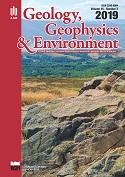Modelling of the reactor cycle cost for thorium-fuelled PWR and environmental aspects of a nuclear fuel cycle
DOI:
https://doi.org/10.7494/geol.2019.45.3.207Keywords:
thorium, PWR, fuel cycle, levelized costs, environmental impactAbstract
The paper presents the methodology applied to the cost modelling of the uranium-thorium nuclear reactor cycle for PWR reactors as well as brief introduction to the environmental impact of the nuclear fuel cycle. The reactor core contains seed uranium fuel and blanket thorium fuel. In such a cycle, energy is produced in the fission of 235U included in the fresh fuel and in the fission of 233U bread from the fertile 232Th. A modified methodology developed by the OECD Nuclear Energy Agency was used for the reactor cycle cost modelling. The method is based on the levelized lifetime cost methodology for a reactor cycle, which is directly related to the heavy metal mass balance. Contrary to the case of uranium-fuelled nuclear reactors, the cost modelling includes the additional cash flow for thorium fuel. The abundance of thorium in the Earth’s crust is about 3–5 times larger than that of uranium, which suggests its promising potential as a nuclear fuel. However, this needs to be proved economically.
Downloads
References
Ashley S.F., Lindley B.A., Parks G.T., Nuttall W.J., Gregg R., Hesketh K.W., Kannan U., Krishnani P.D., Singh B., Thakur A., Cowper M. & Talamo A., 2014. Fuel cycle modelling of open cycle thorium-fuelled nuclear energy systems. Annals of Nuclear Energy, 69, 314–330.
Choi S., Lee H.J. & Ko W.I., 2014. Dynamic analysis of once-through and closed fuel cycle economics using Monte Carlo simulation. Nuclear Engineering and Design, 277, 234–247.
De Roo G. & Parsons J.E., 2011. A methodology for calculating the levelized cost of electricity in nuclear power systems with fuel recycling. Energy Economics, 33, 826–839.
Gyorgy H. & Czifrus S., 2016. The utilization of thorium in Generation IV reactors. Progress in Nuclear Energy, 93, 306–317. IAEA, 2005. Thorium fuel cycle – Potential benefits and challenges. IAEA-TECDOC-1450, International Atomic Energy Agency.
IAEA, 2012. Role of thorium to supplement fuel cycles of future nuclear energy systems. IAEA Nuclear Energy Series No. NF-T-2.4, International Atomic Energy Agency.
IAEA, 2014. INPRO Methodology for Sustainability Assessment of Nuclear Energy Systems: Economics.
IAEA Nuclear Energy Series No. NG-T-4.4, International Atomic Energy Agency.
IAEA, 2019a. THDEPO World Thorium Deposits and Re-sources. International Atomic Energy Agency, [on-line:] https://infcis.iaea.org/THDEPO/About.cshtml [access: 10.10.2019].
IAEA, 2019b. UDEPO World Distribution of Uranium Deposits. International Atomic Energy Agency, [on-line:] https://infcis.iaea.org/UDEPO/About [access: 10.10.2019].
Khatib H. & Difiglio C., 2016. Economics of nuclear and renewables. Energy Policy, 96, 740–750.
Kidd S.W., 2013. Nuclear power – Economics and public acceptance. Energy Strategy Reviews, 1, 277–281.
Lamarsh J. & Barrata A., 2001. Introduction to Nuclear Engineering. 3rd ed. Prentice Hall, New Jersey.
Linares P. & Conchado A., 2013. The economics of new nu-clear power plants in liberalized electricity markets. Energy Economics, 40, 119–125.
Litmanen T., Kari M., Kojo M. & Solomon B.D., 2017. Is there a Nordic model of final disposal of spent nuclear fuel? Governance insights from Finland and Sweden. Energy Research and Social Science, 25, 19–30.
Moore M., Korinny A., Shropshire D. & Sadhankar R., 2017. Benchmarking of nuclear economics tools. Annals of Nuclear Energy, 103, 122–129.
OECD NEA, 1989. Plutonium Fuel, An assessment. Organisation for Economic Cooperation and Development, Nuclear Energy Agency.
OECD NEA, 1994. The economics of the nuclear fuel cycle. Organisation for Economic Co-operation and Development, Nuclear Energy Agency.
OECD NEA, 2016. Uranium 2016: Resources, Production and Demand. Organisation for Economic Co-operation and Development, Nuclear Energy Agency.
OECD NEA, 2018. The Full Costs of Electricity Provision. Organisation for Economic Co-operation and Development, Nuclear Energy Agency.
Schulz W.W., 2014. Thorium processing. Encyclopædia Britannica, inc, [on-line:] https://www.britannica.com/technology/thorium-processing [access: 10.10.2019].
Serfonteina D.E. & Mulder E.J., 2014. Thorium-based fuel cycles: Reassessment of fuel economics and proliferation risk. Nuclear Engineering and Design, 271, 106–113.
Shropshire D.E., Williams K., Boore W., Smith J., Dixon B., Gougar MI, Adams R., Gombert D. & Schneider E., 2009. Advanced Fuel Cycle Cost Basis. Idaho National Laboratory, INL/EXT-07-12107 Rev. 2.
Wang D., 2003. Optimization of a Seed and Blanket Thorium-Uranium Fuel Cycle for Pressurized Water Reactor. Massachusetts Institute of Technology.
WEC, 1984. The Westinghouse Pressurized Water Reactor Nuclear Power Plant. Westinghouse Electric Corporation, Water Reactor Divisions.
WNA, 2017. The Nuclear Fuel Cycle. World Nuclear Association, [on-line:] http://www.world-nuclear.org/informa-tion-library/nuclear-fuel-cycle/introduction/nuclear-fu-el-cycle-overview.aspx [access: 10.10.2019].
WNA, 2019. Uranium Enrichment. World Nuclear Association, [on-line:] http://www.world-nuclear.org/in-formation-library/nuclear-fuel-cycle/conversion-en-richment-and-fabrication/uranium-enrichment.aspx [access: 10.10.2019].
Downloads
Published
Issue
Section
License
Authors have full copyright and property rights to their work. Their copyrights to store the work, duplicate it in printing (as well as in the form of a digital CD recording), to make it available in the digital form, on the Internet and putting into circulation multiplied copies of the work worldwide are unlimited.
The content of the journal is freely available according to the Creative Commons License Attribution 4.0 International (CC BY 4.0)










